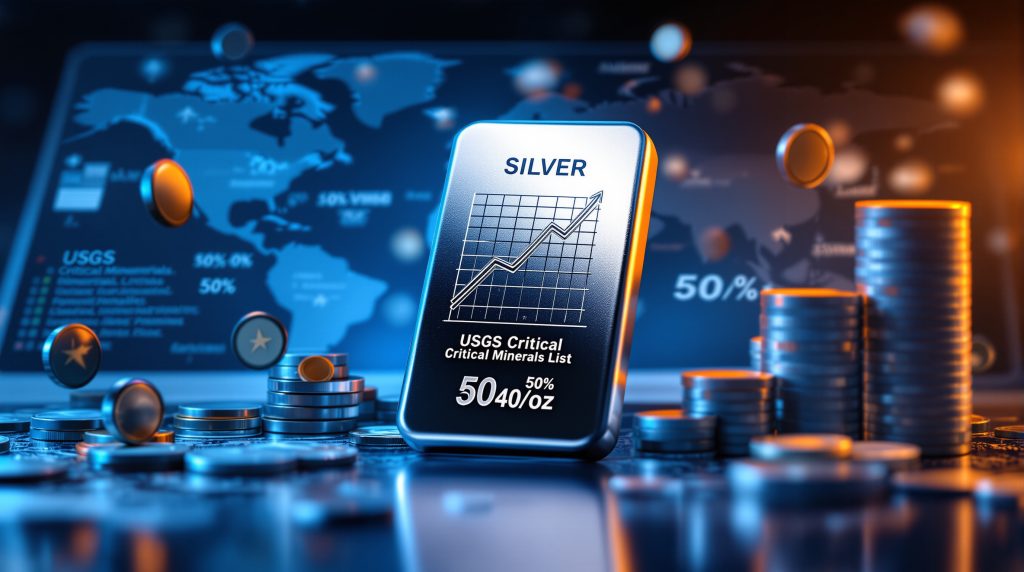How Are Silver Tariffs Reshaping Global Markets?
Silver has experienced a remarkable price surge, crossing the $40 threshold in late August for the first time since 2011. This dramatic rally stems from a complex interplay of supply chain constraints and emerging trade policies that have fundamentally altered market dynamics. The implementation of tariffs on metals has created unprecedented market conditions characterized by supply limitations and surging demand.
The precious metal's impressive performance—gaining over 37% year-to-date—has significantly outpaced both gold (33%) and the S&P 500 (9%), capturing investor attention worldwide. This outperformance comes against a backdrop of five consecutive years of structural supply deficits, creating a foundation for price appreciation even before the current silver tariffs impact considerations.
Current Market Conditions
Physical silver demand has reached extraordinary levels, as evidenced by elevated Exchange for Physical (EFP) premiums. These premiums—the additional cost paid above futures prices to secure actual metal delivery—serve as a critical barometer of physical market tightness. When EFP premiums rise significantly, it signals institutional buyers are willing to pay substantial premiums to secure guaranteed physical delivery.
Institutional investors have shifted strategy, actively securing physical silver allocations rather than relying solely on paper contracts. This fundamental change in approach stems from growing concerns about future metal availability should trade restrictions materialize.
Key Market Catalysts
Several factors are driving the current silver market dynamics:
- Supply chain constraints limiting availability and creating bottlenecks
- New tariff implementations affecting metal imports and trade flows
- Critical minerals designation reshaping how countries approach resource security
- Profitable arbitrage opportunities emerging from market dislocations
The market's structure has fundamentally shifted, with investors now prioritizing guaranteed physical delivery over paper contracts, even when it means paying significant premiums.
What Triggered Silver's Price Breakout?
The catalyst for silver's dramatic price surge can be traced to specific policy developments that reshaped market expectations. A series of regulatory decisions created a framework where silver suddenly found itself at the center of trade policy considerations.
The Copper Tariff Precedent
The United States implemented a significant 50% tariff on copper imports, specifically targeting finished and semi-finished products while excluding raw ores and refined copper. This policy decision, aimed at promoting domestic production for national security reasons, established a precedent with significant implications for other metals.
The copper tariff impact highlighted several important aspects that would later influence silver market dynamics:
- The 50% tariff rate was applied selectively rather than universally
- Strategic exemptions were created for raw ores and refined copper
- National security justifications similar to previous steel/aluminum policies provided the legal framework
- Immediate market impact included significant futures price volatility
Market Reaction to Copper Tariffs
The market's response to copper tariffs provides valuable insight into how similar measures might affect silver. Prior to the tariff announcement, copper futures climbed to $5.59/lb in anticipation of supply disruptions. However, when the details were revealed—including key exemptions—futures collapsed to $4.35/lb the next day, representing a stunning 22% single-day decline.
This dramatic price movement demonstrates how policy details, particularly exemptions, can fundamentally reshape market expectations and pricing. The long-term impact resulted in copper prices stabilizing with a premium that reflected the new market reality.
Silver's Critical Mineral Designation
A pivotal development occurred when the United States Geological Survey released a draft of its updated critical minerals list, which included silver for the first time. This designation represents a significant policy shift with profound market implications.
The critical mineral status carries several important implications:
- It creates potential for similar tariff treatment as seen with copper
- It represents formal recognition of silver's strategic importance to national security
- It signals heightened government focus on securing domestic supply chains
- It establishes the legal framework necessary for implementing trade restrictions
This designation fundamentally altered market perceptions about silver's future availability and pricing, triggering a rush for physical metal.
How Are Institutional Investors Responding?
The reaction from institutional market participants has been swift and decisive, with significant shifts in positioning and risk management strategies.
Risk Management Strategies
Institutional investors and exchanges are prioritizing risk mitigation over profit maximization in the current environment. This cautious approach is reflected in their willingness to pay premiums for guaranteed physical delivery rather than relying on futures contracts that might face delivery complications if tariffs are implemented.
Several market signals indicate this institutional positioning:
- Elevated lease rates for physical silver (the cost to borrow physical metal)
- Increased Exchange for Physical (EFP) premiums reflecting demand for actual metal
- Strategic stockpiling ahead of potential policy changes
- Strong preference for secured physical delivery over futures contracts
In a globalized world with free trade as the norm, silver can typically be stored overseas where holding costs are lower, then shipped when and where needed. However, if tariffs are implemented, this calculation changes dramatically, forcing institutions to secure domestic metal supplies regardless of cost.
Arbitrage Opportunities
The current market dislocation has created profitable arbitrage windows for sophisticated investors who can navigate the complexities of physical and paper markets. These opportunities exist in several forms:
- Price differentials between futures and physical markets
- Geographic arbitrage between different storage locations
- Timing arbitrage based on delivery schedules
- Regulatory arbitrage exploiting policy exemptions
For traders with access to physical metal and the ability to navigate complex logistics, these dislocations present significant profit potential—at least until markets normalize or policy details are clarified.
What Are the Possible Policy Scenarios and Market Outcomes?
The future trajectory of silver prices hinges primarily on policy decisions. Three distinct scenarios have emerged, each with different implications for market participants.
Scenario 1: No Silver Tariffs Materialize
If silver tariffs don't materialize despite market expectations, we could see a gradual unwinding of risk premiums, though some elevated pricing may persist. This scenario might occur if policymakers determine silver's monetary role should exempt it from industrial metal tariffs.
Market implications would likely include:
- Gradual normalization of lease rates as risk premiums dissipate
- Slow reduction of physical premiums as supply concerns ease
- Potential price correction but likely stabilization above pre-speculation levels
- Reduced arbitrage opportunities as markets realign
Even in this scenario, the psychological impact of silver's critical mineral designation would likely leave a lasting footprint on pricing, maintaining some premium over previous levels.
Scenario 2: Copper-Style Tariff Implementation
Silver could follow copper's blueprint with high tariffs paired with exemptions for raw and refined products that underpin exchange settlements. This approach would target value-added products while preserving exchange market functionality.
The potential market reaction would include:
- Swift market reset similar to copper's 22% correction
- Rapid evaporation of current premiums and arbitrage opportunities
- Revaluation based on specific exemption details
- Restructuring of supply chains to optimize around exemptions
This scenario would trigger significant volatility as markets digest the specific policy details and reshape supply chains accordingly.
Scenario 3: Broad Tariffs Without Exemptions
The least likely but most impactful scenario involves comprehensive tariffs without significant exemptions, fundamentally reshaping silver's supply-demand dynamics.
Such a policy would trigger transformative market effects:
- Sustained rally potentially testing all-time highs near $50/oz
- Permanent elevation of physical premiums for domestic metal
- Complete restructuring of global silver supply chains
- Development of regional pricing mechanisms and premiums
While this scenario has the lowest probability, it carries the most significant market impact potential, creating conditions for a sustained silver market squeeze.
How Does Silver's Dual Role Influence Its Market Behavior?
Silver occupies a unique position in the commodities space, functioning simultaneously as both an industrial input and a monetary asset. This dual identity creates distinctive market dynamics not seen in other metals.
Industrial Metal vs. Monetary Asset
Silver's split personality makes it particularly responsive to disruptions in trade, policy, and financial conditions. Its industrial applications continue to expand while its monetary role remains firmly established.
Key industrial applications include:
- Electronics and electrical contacts (largest industrial use)
- Solar panel production (fastest growing segment)
- Medical applications and antimicrobial uses
- Photography (diminished but still present)
Its monetary characteristics include:
- Historical use as currency (hence the term "silver standard")
- Store of value during economic uncertainty
- Inflation hedge properties during monetary expansion
- Portfolio diversification benefits through low correlation with other assets
This dual role means silver responds to both industrial demand factors (economic growth, technological development) and monetary factors (inflation expectations, currency devaluation, financial instability).
Comparative Performance Analysis
Silver's recent performance has been impressive compared to other asset classes, though its historical track record shows significant volatility. This volatility stems directly from its dual nature—industrial demand can collapse during economic contractions while monetary demand surges during financial instability.
Silver's price movements often amplify gold's trends, earning it the nickname "gold on steroids." This leverage effect stems from silver's smaller market size, making it more susceptible to supply-demand imbalances.
Historical data shows that during precious metals bull markets, silver typically outperforms gold in percentage terms. However, during corrections, silver's declines are usually more severe, highlighting its higher volatility profile.
What Historical Parallels Can Guide Future Expectations?
Understanding silver's past price spikes provides valuable context for interpreting current market conditions and potential outcomes.
Previous Silver Price Spikes
Both of silver's past rallies toward $50/oz emerged from extraordinary market conditions that share some similarities with today's environment.
The first major spike occurred during what became known as "Silver Thursday" in 1980:
- The Hunt brothers attempted to corner the silver market
- Prices reached $49.45/oz before collapsing
- Regulatory intervention ultimately ended the rally
- Market manipulation rather than fundamental drivers powered the move
The second major spike happened during the post-financial crisis period in 2011:
- Government bailouts and stimulus measures raised inflation concerns
- Fears of currency debasement fueled precious metals demand
- Investor flight to hard assets drove prices higher
- Prices peaked near $49/oz before entering a multi-year bear market
Current Rally Distinguishing Factors
Today's silver rally differs from previous spikes in several important ways:
- Supply deficits entering their fifth consecutive year create a fundamental foundation
- Tariffs and market impact represent a new factor not present in previous rallies
- Critical mineral designation provides government recognition of silver's strategic importance
- Institutional rather than retail-driven demand dominates the current market
These distinguishing factors suggest the current rally may have more sustainable fundamental support than previous price spikes, though policy decisions remain the wild card.
What Should Investors Monitor Going Forward?
Given the significant role policy decisions will play in silver's future, investors should focus on specific indicators that will provide early warning of market direction.
Key Policy Developments
The future trajectory of silver prices hinges significantly on policy decisions related to tariffs, critical minerals, and international trade.
Investors should monitor several policy indicators:
- Executive orders regarding precious metals and critical minerals
- Updates to the critical minerals list and implementation timelines
- Specific exemption details for any implemented tariffs
- International trade negotiations and potential retaliatory measures
Policy statements from officials and regulatory agencies will provide crucial insights into how silver might be treated under new trade frameworks.
Market Signals
Beyond policy developments, several market metrics can provide early indications of shifting dynamics in the silver market.
Leading indicators to watch include:
- Lease rates for physical silver (the cost to borrow physical metal)
- Exchange for Physical (EFP) premiums (widening spreads signal physical demand)
- Inventory levels at major exchanges (declining inventories suggest physical demand)
- Positioning data from Commitment of Traders reports (institutional positioning)
These metrics provide real-time feedback on how market participants are responding to evolving conditions and can signal trend changes before they appear in spot prices.
Silver Tariffs: Market Impact and Investment Implications
The silver market stands at a pivotal crossroads, with policy decisions likely to determine whether the current rally above $40 represents the beginning of a sustained uptrend or a temporary peak driven by speculation.
Silver's unique position as both an industrial metal and a monetary asset makes it particularly vulnerable to trade policy disruptions. The designation as a critical mineral has fundamentally altered market psychology, forcing institutional players to secure physical metal regardless of cost.
The precedent established by copper tariffs provides a blueprint for what might occur with silver, though the details—particularly exemptions—will ultimately determine market impact. Investors must remain vigilant for policy announcements while monitoring key market signals that indicate physical demand trends.
For those considering silver investments, understanding the three potential policy scenarios provides a framework for managing risk. The least likely outcome—broad tariffs without exemptions—ironically carries the greatest price impact potential, potentially driving silver toward its previous all-time highs.
Regardless of which scenario unfolds, silver's strategic importance has been elevated through its critical mineral designation. This recognition suggests that regardless of near-term price movements, silver's role in both industrial applications and investment portfolios will likely grow in significance in the coming years.
The convergence of structural supply deficits, critical mineral status, and potential trade restrictions has created unprecedented conditions in the silver market. While uncertainty remains high, one thing appears certain: silver's days of being overlooked as "poor man's gold" may be ending as its strategic importance gains recognition. For investors looking to navigate this complex landscape, developing appropriate silver price strategies will be essential to capitalize on the opportunities while managing the considerable risks.
Ready to Invest in the Next Major Mineral Discovery?
Stay ahead of the market with Discovery Alert's proprietary Discovery IQ model, which instantly notifies investors of significant ASX mineral discoveries, turning complex data into actionable insights. Visit the Discovery Alert's discoveries page to understand why historic discoveries can generate substantial returns and begin your 30-day free trial today.




